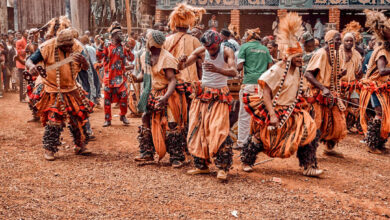Tribal Affairs & Partnerships – Yellowstone National Park (U.S. National Park Service)
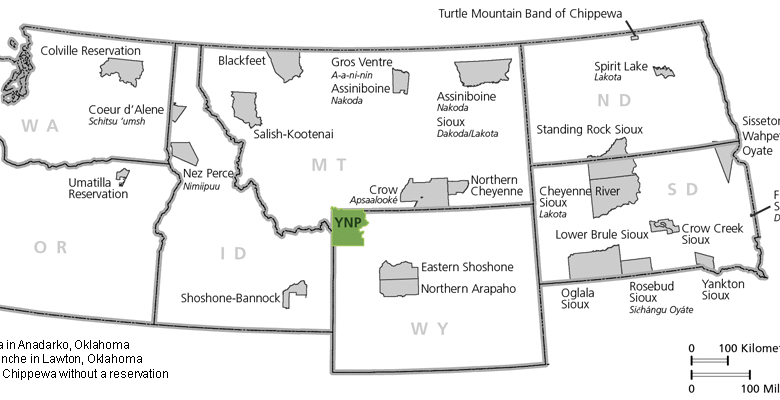
Our Goals
We respect and strengthen Indigenous connections to Yellowstone and their role in park stewardship.
Indigenous stories, traditions, and ethnographic resources are an important part of the history and current stewardship of Yellowstone. Creating space for Indigenous people to share their own connections to the land and including these perspectives is a critical part of stewarding Yellowstone.
We enhance Nation-to-Nation relationships.
To honor the federal Indian trust responsibility, the National Park Service consults with Yellowstone’s Associated Tribes, who are sovereign nations, on a government-to-government basis when making decisions that affect culturally significant resources.
We incorporate Indigenous perspectives and voices into interpretation and education programming.
Yellowstone offers opportunities for visitors to hear directly from Tribal members at the Yellowstone Tribal Heritage Center and special Indigenous cultural events and to learn about Tribes through publications, exhibits, and educational programs.
Associated Tribes
NPS / Yellowstone Spatial Analysis Center
There are currently 27 Tribes who have historic and modern connections to the lands and resources now found within Yellowstone National Park.
- Assiniboine and Sioux Tribes of the Fort Peck Indian Reservation, Montana
- Blackfeet Tribe of the Blackfeet Indian Reservation of Montana
- Cheyenne River Sioux Tribe of the Cheyenne River Reservation, South Dakota
- Coeur d’Alene Tribe
- Comanche Nation, Oklahoma
- Confederated Salish and Kootenai Tribes of the Flathead Reservation
- Confederated Tribes of the Colville Reservation
- Confederated Tribes of the Umatilla Indian Reservation
- Crow Creek Sioux Tribe of the Crow Creek Reservation, South Dakota
- Crow Tribe of Montana
- Eastern Shoshone Tribe of the Wind River Reservation, Wyoming
- Flandreau Santee Sioux Tribe of South Dakota
- Fort Belknap Indian Community of the Fort Belknap Reservation of Montana
- Kiowa Indian Tribe of Oklahoma
- Little Shell Tribe of Chippewa Indians of Montana
- Lower Brule Sioux Tribe of the Lower Brule Reservation, South Dakota
- Nez Perce Tribe
- Northern Arapaho Tribe of the Wind River Reservation, Wyoming
- Northern Cheyenne Tribe of the Northern Cheyenne Indian Reservation, Montana
- Oglala Sioux Tribe
- Rosebud Sioux Tribe of the Rosebud Indian Reservation, South Dakota
- Shoshone-Bannock Tribes of the Fort Hall Reservation
- Sisseton-Wahpeton Oyate of the Lake Traverse Reservation, South Dakota
- Spirit Lake Tribe, North Dakota
- Standing Rock Sioux Tribe of North and South Dakota
- Turtle Mountain Band of Chippewa Indians of North Dakota
- Yankton Sioux Tribe of South Dakota
Tribal Affairs
Park managers with the National Park Service meet periodically with Tribal representatives for government-to-government consultations to formally exchange information about park projects and ethnographic resources. Tribes provide input into resource management and decision-making, conduct ceremonies and other events in the park, and identify plants and minerals for traditional uses.

Bison Management
Many Tribes have a physical and spiritual connection to bison in Yellowstone. Starting in 2007, some Associated Tribes have exercised their treaty rights and conducted bison hunts outside the park.
Starting in 2009, the Confederated Salish and Kootenai Tribes of the Flathead Reservation, the InterTribal Buffalo Council, and the Nez Perce Tribe have joined the Interagency Bison Management Plan and participate in the development of adaptive management strategies for bison and brucellosis in the areas immediately outside Yellowstone.
Learn more about bison management in Yellowstone.
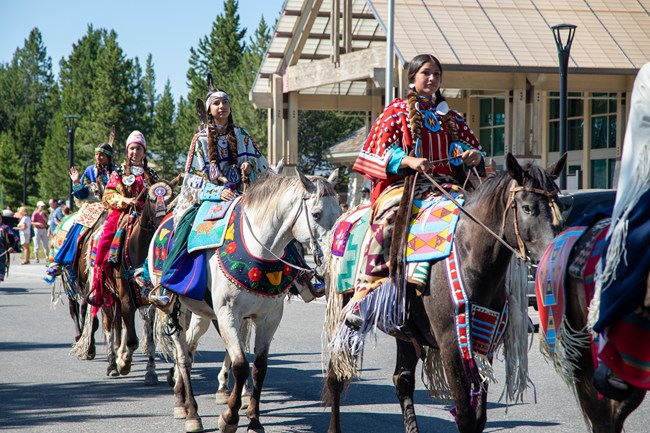
Tribal Representation
In 2018, the park consulted with Associated Tribes on increasing opportunities for non-consumptive ceremonial use of the park. Consultants also reviewed park educational media and programming for representation of native peoples and perspectives.
Previous education consultation focused on the Yellowstone segment of the Nez Perce National Historic Trail and the associated sites and events of the 1877 Flight of the Nez Perce and the park has worked with many other Tribes on vetting educational content. In partnership with Yellowstone Forever, the park continually works with a collaborative group of Indigenous educators to review and incorporate Indigenous perspectives into the park’s educational content.

Park Place Names
In 2016, the Executive Committee of the Blackfoot Nation contacted Yellowstone National Park to request name changes of two locations inside the park. National place names are managed by the United States Geologic Survey (USGS), and the representatives were referred to the USGS Board of Geographic Names at that time. The committee requested the park change Mount Doane to “First Peoples Mountain” and change Hayden Valley to “Buffalo People’s Valley.”
In 2022, the USGS, based on a recommendation by the NPS, changed the name of Mount Doane to First People’s Mountain.
Tribal Partnerships
In addition to formal government-to-government consultations, park managers with the National Park Service also partner with Indigenous advisors and nonprofits to increase the Indigenous presence in the park and create opportunities for Tribal members to tell their stories directly to visitors.

YF/ Alyssa McGeeley
Tribal Engagement Manager
In 2023, with support from Yellowstone Forever, Yellowstone hired a Tribal Engagement Manager to oversee the Yellowstone Tribal Heritage Center and continue the ongoing work of engaging Indigenous people and perspectives into the park’s programs and operations.
Yellowstone Tribal Heritage Center
In partnership with Yellowstone Forever, Yellowstone successfully opened the Yellowstone Tribal Heritage Center in summer 2022. The center brings together Indigenous artists, scholars, and presenters from Yellowstone’s associated Tribal Nations to directly engage visitors through formal and informal education, demonstrations, and storytelling. The project is informed by and staffed by Indigenous partners through the summer season.
Learn more about the Yellowstone Tribal Heritage Center and view the schedule of presenters.
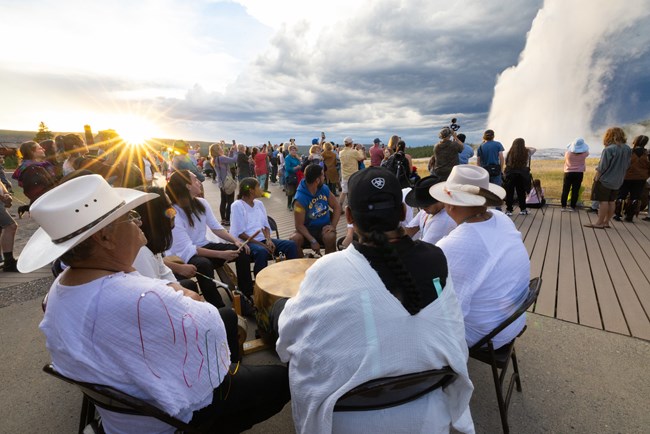
Tribal Internship Program
The park works with several different entities to create internships for Tribal members. This includes Salish Kootenai College, the Salish Kootenai Tribal Historic Preservation Office, the Greater Yellowstone Coalition, Yellowstone Forever, the InterTribal Buffalo Council and the University of Montana. Interns have gained valuable experience working varied roles such as bison, native fish conservation, archeology, invasive species, and interpretation and education.
Yellowstone Revealed
In partnership with Mountain Time Arts, Yellowstone hosts a series of place-based projects by an interTribal group of Indigenous artists and scholars. During the event, visitors can interact with members from Yellowstone’s Associated Tribes to learn about their heritage and culture through storytelling, demonstrations, art installations, and performances. Plans are underway for a third installation during the summer of 2024.

Illuminated Teepee Installation
As part of Yellowstone’s 150th anniversary, the Pretty Shield Foundation and Rocky Mountain Tribal Leaders Council successfully installed seven illuminated teepees by Roosevelt Arch in Gardiner, Montana. Additional event partners include Yellowstone Forever, Yellowstone National Park Lodges, the National Parks Conservation Association, the Greater Yellowstone Coalition, and Park County Environmental Council. Plans are underway for a third installation during the summer of 2024.
- Duration:
- 10 minutes, 18 seconds
To celebrate Yellowstone’s 150th anniversary, Yellowstone Tribal Heritage Center Coordinator Alyssa McGeeley talks about Yellowstone’s pilot program in partnership with Yellowstone Forever.
All these terms are acceptable, but it’s best to ask people about their individual preferences. In the United States, Native American has been widely used but is falling out of favor with some groups, and the terms American Indian or Indigenous American are preferred by many Native people. Native peoples often have individual preferences on how they would like to be addressed. When talking about Native groups or people, use the terminology the members of the community use to describe themselves collectively.
A Tribal consultation is a formal, two-way, government-to-government dialogue between official representatives of Tribes and Federal agencies to discuss Federal proposals before the Federal agency makes decisions on those proposals. The Federal agency provides sufficient advance notice to appropriate Tribal leaders of upcoming consultation sessions and, following the consultation sessions, explains to those Tribal leaders how the final agency decision incorporates Tribal input.
Approximately 56.2 million acres are held in trust by the United States for various Indian Tribes and individuals. There are approximately 326 Indian land areas in the U.S. administered as federal Indian reservations (i.e., reservations, pueblos, rancherias, missions, villages, communities, etc.). The largest is the 16 million-acre Navajo Nation Reservation located in Arizona, New Mexico, and Utah. The smallest is a 1.32-acre parcel in California where the Pit River Tribe’s cemetery is located. Many of the smaller reservations are less than 1,000 acres.
Some reservations are the remnants of a Tribe’s original land base. Others were created by the federal government for the resettling of Indian people forcibly relocated from their homelands. Not every federally recognized Tribe has a reservation.
Land acknowledgments are oral or written statements used to recognize Indigenous peoples as the original stewards of the lands on which a person may live, work, or go to school. Land acknowledgment is a traditional custom that dates back centuries for many Native nations and communities. For example, in Coast Salish communities along the Pacific Coast, another Tribe or nation would ask permission to come ashore, thus acknowledging they were visitors to the lands. Acknowledging original Indigenous inhabitants today is often complex because of the centuries of displacement experienced by many Native peoples through (broken) treaties, government policy, and relocation efforts. Throughout their histories, Native groups have relocated and successfully adapted to new places and environments. Many Native peoples are active members of urban communities today.
From 1778 to 1871, the United States’ relations with individual American Indian Nations indigenous to what is now the U.S. were defined and conducted largely through the treaty-making process. These “contracts among nations” recognized and established unique sets of rights, benefits, and conditions for the treaty-making Tribes who agreed to cede of millions of acres of their homelands to the United States and accept its protection. Like other treaty obligations of the United States, Indian treaties are “the supreme law of the land,” and they are the foundation upon which federal Indian law and the federal Indian trust relationship is based.
The federal Indian trust responsibility is also a legally enforceable fiduciary obligation on the part of the United States to protect Tribal treaty rights, lands, assets, and resources, as well as a duty to carry out the mandates of federal law with respect to American Indian and Alaska Native Tribes and villages. In several cases discussing the trust responsibility, the Supreme Court has used language suggesting that it entails legal duties, moral obligations, and the fulfillment of understandings and expectations that have arisen over the entire course of the relationship between the United States and the federally recognized Tribes.
Forms of co-stewardship may, among other forms, include sharing of technical expertise; combining Tribal and bureau capabilities to improve resource management and advance the responsibilities and interests of each; making Tribal and Alaska Native knowledge, experience, and perspectives integral to the public’s experience of Federal lands; and entering annual funding agreements under the Tribal Self-Governance Act.
Furthermore, federally recognized Tribes are recognized as possessing certain inherent rights of self-government (i.e., Tribal sovereignty) and are entitled to receive certain federal benefits, services, and protections because of their special relationship with the United States. At present, there are 574 federally recognized American Indian and Alaska Native Tribes and villages.
The United States still recognizes this unique political status and relationship today.
The relationship between federally recognized Tribes and the United States is one between sovereigns, i.e., between a government and a government. This “government-to-government” principle, which is grounded in the United States Constitution, has helped to shape the long history of relations between the federal government and these Tribal nations.
-
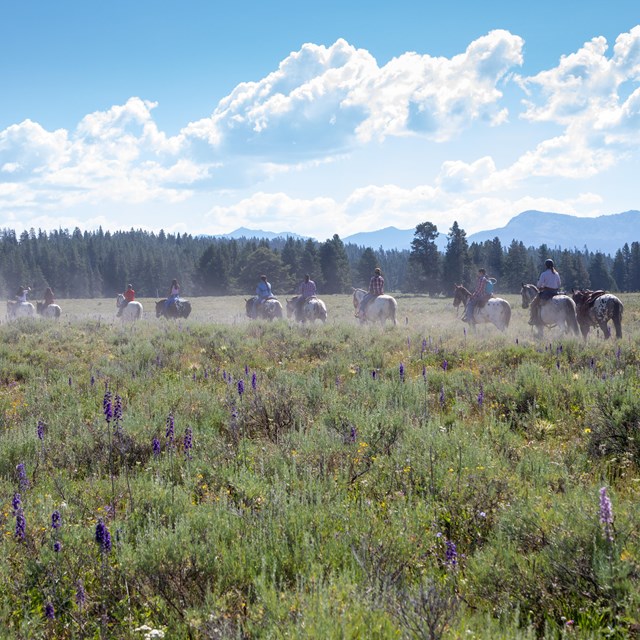
The Nez Perce Flight of 1877
Members of Nez Perce Appaloosa Horse Club and park staff rode sections of the Nez Perce Trail. Learn more about the Nez Perce Flight of 1877
-
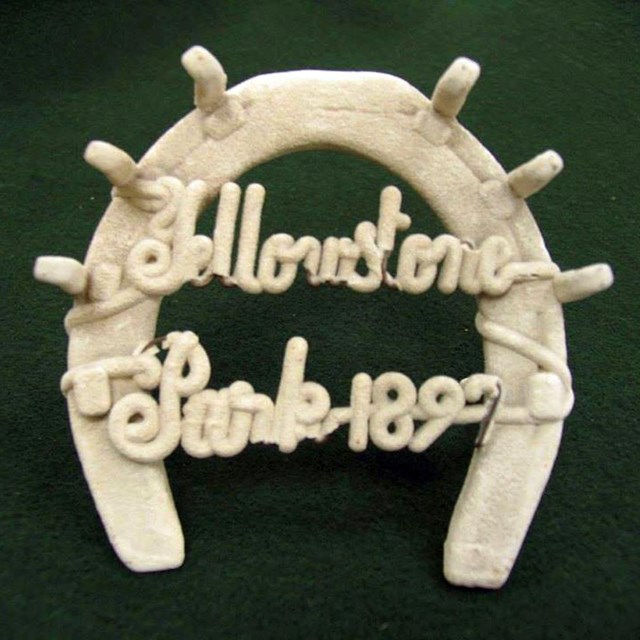
Yellowstone’s Collections
The Heritage and Research Center houses Yellowstone’s extensive museum collection, archives, and research library.
Tribal Affairs & Partnerships News
Source link



